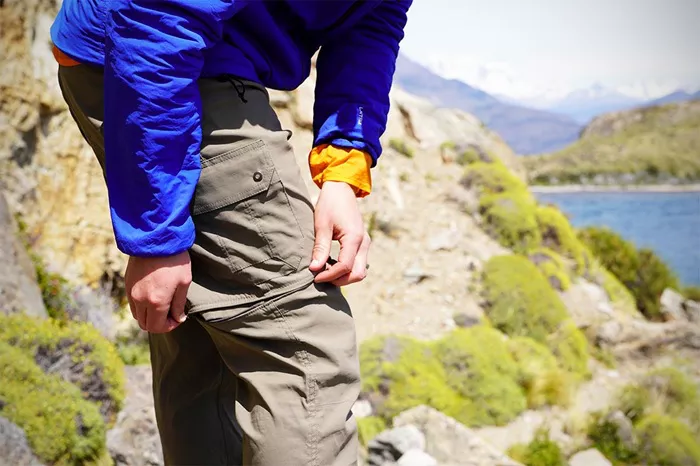Hiking in summer offers warm weather, long days, and stunning landscapes. However, the season’s heat, sun exposure, and unpredictable weather demand careful preparation—especially when choosing what to wear. Pants are a critical part of your hiking gear, as they protect your legs, provide comfort, and influence your overall performance. This essay explores the key features of ideal summer hiking pants, including material, breathability, moisture management, sun protection, durability, fit, and additional functional details. By understanding these factors, you can make informed choices to enhance your hiking experience.
Material: The Foundation of Comfort
The fabric of your pants determines how they feel, perform, and adapt to summer conditions.
Synthetic Fabrics
Most hiking pants are made from synthetic materials like nylon or polyester. These fabrics are lightweight, quick-drying, and durable. Nylon is known for its strength and resistance to abrasion, making it ideal for rugged trails. Polyester excels at wicking moisture away from the skin, keeping you dry during intense activity. Many pants blend these materials to balance durability and breathability.
Merino Wool Blends
Merino wool is naturally odor-resistant and temperature-regulating, making it suitable for multi-day hikes. However, pure wool can feel too warm for summer. Blends with synthetics (e.g., 85% nylon, 15% merino) offer a lighter, breathable option with odor control.
Avoid Cotton
Cotton absorbs sweat and dries slowly, leaving you damp and increasing chafing risks. Save cotton for casual outings, not strenuous summer hikes.
Breathability: Staying Cool in the Heat
Breathable pants allow air to circulate, preventing overheating.
Loose Weaves and Ventilation
Look for pants with a loose fabric weave or mesh panels in high-sweat areas (e.g., behind the knees or along the thighs). Some designs include zippered vents near the hips or thighs to boost airflow.
Lightweight Construction
Ultra-lightweight fabrics (e.g., 40–70 denier nylon) reduce bulk and improve ventilation. However, they may sacrifice durability on rocky terrain.
Moisture Management: Wicking Away Sweat
Sweat can lead to discomfort, chafing, or even rashes. Effective moisture management is essential.
Moisture-Wicking Technology
Synthetic fabrics pull sweat to the surface, where it evaporates quickly. Look for terms like “wicking” or “quick-dry” on product labels.
DWR Coating
A durable water-repellent (DWR) finish sheds light rain or morning dew. While not fully waterproof, it keeps you dry during brief showers.
Sun Protection: Shielding Your Skin
Prolonged sun exposure increases the risk of burns and long-term damage.
UPF Ratings
Many hiking pants have UPF (Ultraviolet Protection Factor) ratings. UPF 30+ blocks 97% of UV rays; UPF 50+ blocks 98%. Tight weaves or synthetic fibers with built-in UV inhibitors offer superior protection.
Coverage and Fit
Full-length pants protect more skin than shorts. Opt for a relaxed fit to avoid gaps where sunlight can reach your legs.
Light Colors
Light-colored fabrics (e.g., beige, light gray) reflect sunlight better than dark tones.
Durability: Balancing Weight and Strength
Summer trails vary from smooth paths to thorny brush. Your pants must withstand wear without weighing you down.
Reinforced Areas
Look for reinforced knees, seat, or cuffs if hiking through rough terrain. Ripstop fabrics (woven with thicker threads in a grid pattern) resist tears.
Denier Ratings
Denier measures fabric thickness. For summer:
- 20–50 denier: Ultra-lightweight, ideal for easy trails.
- 70–100 denier: Midweight, balances breathability and durability.
Fit and Mobility: Moving Freely
Restrictive pants can hinder your stride or cause chafing.
Articulated Knees and Gussets
Pants with articulated knees (pre-shaped stitching) or a gusseted crotch allow natural movement during climbs or scrambles.
Adjustable Waistbands
Elastic waistbands or belt loops accommodate weight fluctuations or layering.
Slim vs. Relaxed Fit
- Slim fit: Lightweight and less likely to snag on branches.
- Relaxed fit: Better airflow and comfort for muscular thighs.
Additional Features: Enhancing Functionality
Small details can make a big difference.
Convertible Designs
Zip-off legs let you switch between pants and shorts as temperatures change.
Pockets and Storage
Zippered pockets secure valuables; thigh pockets offer easy access to maps or snacks.
Insect Protection
Some pants are treated with permethrin, a chemical that repels ticks and mosquitoes.
Roll-Up Tabs
Cuff tabs allow you to shorten pants without cutting or zippers.
Style and Versatility
While function comes first, style matters for multi-use gear. Neutral colors (gray, olive) hide dirt and pair well with other clothing.
Popular Types of Summer Hiking Pants
- Convertible Pants: Versatile for changing weather.
- Trekking Tights: Stretchy and lightweight for fast-paced hikes.
- Loose-Fit Quick-Dry Pants: Budget-friendly and breathable.
Care and Maintenance
Wash pants in cold water and avoid fabric softeners, which clog moisture-wicking fibers. Reapply DWR coatings annually.
Conclusion
Choosing the right summer hiking pants involves balancing breathability, protection, durability, and comfort. Prioritize synthetic fabrics with UPF ratings, moisture-wicking properties, and a functional fit. Test pants on short hikes before committing to long trips. With the right pair, you’ll stay cool, dry, and protected, letting you focus on the beauty of the trail.
Related topics:
What Pants to Hike In: A Complete Guide
What Type of Pants to Wear Hiking
What to Wear on a Long Hike: A Comprehensive Guide

